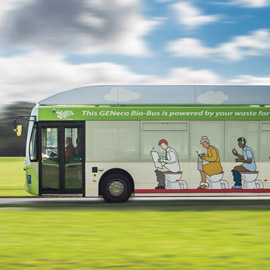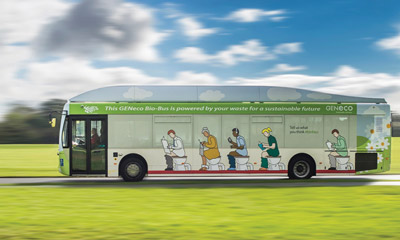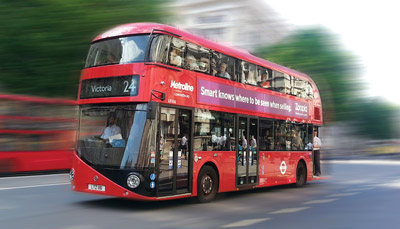The Journey of the Green Bus – from pollution problem to city solution
- Like
- Digg
- Del
- Tumblr
- VKontakte
- Buffer
- Love This
- Odnoklassniki
- Meneame
- Blogger
- Amazon
- Yahoo Mail
- Gmail
- AOL
- Newsvine
- HackerNews
- Evernote
- MySpace
- Mail.ru
- Viadeo
- Line
- Comments
- Yummly
- SMS
- Viber
- Telegram
- Subscribe
- Skype
- Facebook Messenger
- Kakao
- LiveJournal
- Yammer
- Edgar
- Fintel
- Mix
- Instapaper
- Copy Link
Posted: 10 March 2016 | Low Carbon Vehicle Partnership (LowCVP) | No comments yet
In an article for Intelligent Transport, LowCVP discusses finding of its recent report, The Journey of the Green Bus, which considers the impact of policy and innovation on the sector and how the green bus has become part of the solution to poor urban air quality.


In an article for Intelligent Transport, LowCVP discusses finding of its recent report, The Journey of the Green Bus, which considers the impact of policy and innovation on the sector and how the green bus has become part of the solution to poor urban air quality.


A new report by the UK’s Low Carbon Vehicle Partnership (LowCVP) says that ‘greener’, cleaner buses are playing an increasingly important part in cutting carbon emissions from the road transport sector and, in particular, helping to reduce pollution in cities around the UK.
The report – The Journey of the Green Bus – describes how industry innovation and supportive government policy over the last decade and more has transformed the bus sector from being a part of the problem to an important part of the solution to poor urban air quality as well as contributing to tackling climate change.
Air pollution rose up the UK political agenda in early 2015 after an NGO, Client Earth, won a legal case against the Government over the country’s failure to meet EU targets for air quality. It rose even higher up the agenda following the ‘dieselgate’ scandal when VW admitted that ‘defeat devices’ had been fitted to some vehicle models to achieve better emissions test results.


© LowCVP 2016
In response to the legal challenge, the UK Government announced an ‘Air quality plan for nitrogen dioxide’ last December, including plans to introduce Clean Air Zones in five air quality management areas where air quality is particularly poor.
At the same time, the landmark Paris Climate Conference (COP21) of nearly 200 governments – including all the world’s leading countries – agreed a deal to cap global warming at “well below” two degrees above pre-industrial levels, with an aspiration to achieve a lower, long-term 1.5 degree target. Tackling climate change is also high up the list of government priorities and is now truly an international endeavour.
With road transport responsible for around 20% of the UK’s greenhouse gas (GHG) emissions and in many places the majority of the roadside NOx pollution in cities around the UK, firmer initiatives to tackle vehicle emissions are inevitable in the coming years.
A focus on reducing bus emissions is a key priority
With older technology buses historically contributing up to two-thirds of NOx emissions in the most densely trafficked areas, a focus on reducing bus emissions is a key priority.
One of the specific challenges faced by bus operators is the high capital cost of cleaner buses. In order to overcome this barrier, the LowCVP helped to devise two incentive mechanisms in 2009 to help kick-start the low carbon emission bus market – the Bus Service Operators Grant (BSOG) Low Carbon Emission Bus Incentive to help with operating costs, and the Green Bus Fund to assist with the capital outlay. These were adopted by the Department of Transport and embedded into national transport policy.


© LowCVP
Building on many years of work by LowCVP members (in particular Millbrook and Transport for London) the LowCVP developed the innovative criteria for the Low Carbon Emission Bus (LCEB) for the Department for Transport (DfT). These criteria (based on greenhouse gas savings of 30% on a well-to-wheel basis, measured in a real world test) provided the basis for £90m of support under the four rounds of the Government’s Green Bus Fund and resulted in the arrival of around 3,500 buses meeting this LCEB specification. More than one in four buses sold in 2015 was a LCEB and over half of all 2015 bus registrations met the Euro VI emissions standard, which has delivered a dramatic step-change in the emissions of heavy vehicles.
Over half of all 2015 bus registrations met the Euro VI emissions standard
More recently, and to reflect the growing concerns about air quality, the LowCVP supported government in producing the new Low Emission Bus (LEB) criteria which provide the basis for the recently announced Low Emission Bus Grant; a £30 million fund to be run over three years (2016–2019) designed to stimulate the purchase of Low Emission Buses.
In fact, so advanced has the UK bus market become, that it has leapfrogged EU legislation, introducing a comprehensive assessment which covers the whole well-to -wheel carbon and GHG impact of the buses in a real world test. Every impact on climate change is considered; the real effects of methane and nitrogen dioxide are incorporated into the definition. For the green bus there is now no hiding place where exhaust emissions can lurk unchallenged.
A wide range of technical solutions have been adopted and, validated through real world emissions tests, are now delivering clear and demonstrable air quality and carbon benefits. The technologies adopted include the full spectrum of hybrid solutions (plug-in hybrids, diesel-electric hybrids, flywheel hybrids and micro-hybrids); battery electric buses; and a range of fuel solutions including buses powered by hydrogen fuel cells and biomethane.
The green bus has arrived but its journey goes on…
Today’s low emission buses will more than meet the requirements of the recently announced Clean Air Zones. They’re also delivering carbon and fuel savings which benefit the climate and cut operators’ costs. The UK bus industry continues to innovate, drawing on a diverse range of technology and resources from Formula One to farm manure! The UK continues to lead the world in comprehensive assessment of the real impacts and is delivering undoubted benefits from greener buses. The green bus has arrived but its journey goes on…
About the LowCVP
The LowCVP is a public-private, not-for-profit partnership that exists to accelerate a sustainable shift to lower carbon vehicles and fuels and create opportunities for UK businesses. The LowCVP has been – and continues to be – mainly funded by the Department for Transport but with increasing contributions via membership fees and sponsorship/project income. Approaching 200 organisations are members, from diverse backgrounds including automotive and fuel supply chains, vehicle users, academics and environment/not-for-profit bodies.
To download the LowCVP’s report ‘The Journey of the Green Bus’ please click here.
For more information visit: www.lowcvp.org.uk
Related topics
Air Quality, Transport Governance & Policy







